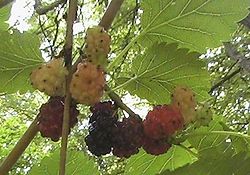Morus or Mulberry is a genus of 10–16 species of deciduous trees native to warm, temperate, and subtropical regions of Asia, Africa, Europe, and the Americas, with the majority of the species native to Asia.
The closely related genus Broussonetia is also commonly known as mulberry, notably the Paper Mulberry, Broussonetia papyrifera.
Mulberries are fast-growing when young, but soon become slow-growing and rarely exceed 10-15 metres (33-49 ft) tall. The leaves are alternately arranged, simple, often lobed, more often lobed on juvenile shoots than on mature trees, and serrated on the margin.
The fruit is a multiple fruit, 2-3 centimetres (0.8-1.2 in) long. The fruits when immature are white or green to pale yellow with pink edges. In most species the fruits are red when they are ripening. A fully ripened mulberry in these species is dark purple to black, edible, and sweet with a good flavor in several species. The fruits of the white-fruited cultivar of the White Mulberry on the other hand are green when unripe and white when ripe; the fruit in this cultivar is sweet, and has a very mild flavor compared with the dark fruits.
Species
The taxonomy of Morus is complex and disputed. Over 150 species names have been published, but only 10–16 are generally cited as being accepted, though different sources cite different selections of accepted names. The classification is also complicated by widespread hybridisation, with the hybrids being fertile.
The following species are generally accepted:
|
|
The following, all from eastern and southern Asia, are additionally accepted by one or more taxonomic lists or studies; synonymy as given by other lists or studies is indicated in parentheses:
|
|
Uses and cultivation
The ripe fruit is edible and is widely used in pies, tarts, wines and cordials. The fruit of the black mulberry, native to southwest Asia, and the red mulberry, native to eastern North America, have the strongest flavor. The fruit of the white mulberry, an east Asian species which is extensively naturalized in urban regions of eastern North America, has a different flavor, sometimes characterized as insipid. The mature fruit contains significant amounts of resveratrol, particularly the skin.[4] The fruit and leaves are sold in various forms as nutritional supplements.
Unripe fruit and green parts of the plant have a white sap that is intoxicating and mildly hallucinogenic.[1]
Black, red and white mulberry are widespread in Northern India, Azerbaijan, Armenia, Pakistan, Iran, and Afghanistan, where the tree and the fruit are known by the Persian-derived names toot (mulberry) or shahtoot (King's or "superior" mulberry). Jams and sherbets are often made from the fruit in this region. Black mulberry was imported to Britain in the 17th century in the hope that it would be useful in the cultivation of silkworms. It was much used in folk medicine, especially in the treatment of ringworm.
Mulberry leaves, particularly those of the white mulberry, are ecologically important as the sole food source of the silkworm (Bombyx mori, named after the mulberry genus Morus), the pupa/cocoon of which is used to make silk. Other Lepidoptera larvae also sometimes feed on the plant including common emerald, lime hawk-moth and the sycamore.
Mulberries can be grown from seed, and this is often advised as seedling-grown trees are generally of better shape and health. But they are most often planted from large cuttings which root readily.
Anthocyanins from mulberry fruits
Anthocyanins are edible pigments which hold potential use as dietary antioxidants providing potential health benefits against a variety of diseases[2][3] and as natural food colorants. As the safety of synthetic pigments is doubted and in the wake of increasing demand for natural food colorants, their significance in food industry is increasing. Anthocyanins yield attractive colors of fresh plant foods such as orange, red, purple, black and blue. Since they are water-soluble, they are easily extractable and incorporated into aqueous food systems.
A cheap and industrially feasible method to purify anthocyanins from mulberry fruit which could be used as a fabric tanning agent or food colorant of high color value (of above 100) has been established. Scientists found that out of 31 Chinese mulberry cultivars tested, the total anthocyanin yield varied from 148 mg to 2725 mg per liter of fruit juice.[4] Total sugars, total acids and vitamins remained intact in the residual juice after removal of anthocyanins and that the residual juice could be fermented in order to produce products such as juice, wine and sauce.
Worldwide, mulberry is grown for its fruit. In traditional and folk medicine, the fruit is believed to have medicinal properties and is used for making jam, wine, and other food products. As the genera Morus has been domesticated over thousands of years and constantly been subjected to heterosis breeding (mainly for improving leaf yield), it is possible to evolve breeds suitable for berry production, thus offering possible industrial use of mulberry as a source of anthocyanins for functional foods or food colorants which could enhance the overall profitability of sericulture.
Anthocyanin content depends on climate, area of cultivation and is particularly higher in sunny climates[citation needed]. This finding holds promise for tropical sericulture countries to profit from industrial anthocyanin production from mulberry through anthocyanin recovery.
This offers a challenging task to the mulberry germplasm resources for
- exploration and collection of fruit yielding mulberry species
- their characterization, cataloging and evaluation for anthocyanin content by using traditional as well as modern means and biotechnology tools
- developing an information system about these cultivars or varieties
- training and global coordination of genetic stocks
- evolving suitable breeding strategies to improve the anthocyanin content in potential breeds by collaboration with various research stations in the field of sericulture, plant genetics and breeding, biotechnology and pharmacology.




Tidak ada komentar:
Posting Komentar